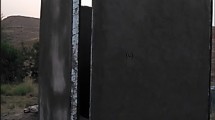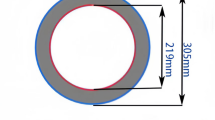Abstract
In the present study, three-dimensional nonlinear finite element analysis is used to investigate the dynamic response of cut and cover tunnel subjected to blast loading. The analyses are performed using a dynamic explicit analysis tool in ABAQUS. The blast load is modeled using the CONWEP blast function available in ABAQUS. The reinforced concrete section is modeled using three-dimensional solid elements and stress–strain response of concrete is simulated using a concrete damaged plasticity model. The reinforcements are modeled using three-dimensional truss elements, and material properties are simulated using a metal plasticity model with isotropic-linear-elasticity. The parametric studies have been performed to evaluate the performance of key structural elements of cut and cover facilities, i.e., top slab and walls considering (1) different cover thickness (buried depth-d) of tunnel to height of tunnel ratio (d/H) (2) explosive charge weight. The mitigation measure using steel polypropylene hybrid fiber-reinforced concrete (HFRC) was also explored to improve the performance of the sections studied. It is observed from results that the displacement of tunnel increases with an increase in charge weight and decreases with an increase in d/H ratio. It can be observed from damage assessment that tension accumulation is the governing factor for the damage of reinforced concrete sections of the cut and cover tunnels and the extent of damage is observed to be reduced by increasing d/H ratio, i.e., increasing burial depth. The intermediate wall of the cut and cover section is the most critical element to avoid the progressive collapse of the structure. It is observed that the use of HFRC in the tunnel as an alternative to conventional concrete improves the blast-resistant capacity of the tunnel.





























Similar content being viewed by others
Availability of data and material
Data used in the present research and material are available upon request.
Code availability
There is no computer code developed through present research. However, the input file used for running the simulation in the ABAQUS computer application is available upon request.
References
Dusenberry DO (2010) Handbook for blast resistant design of buildings. Wiley, Hoboken
Shvetsov A, Sharov V, Kozyrev V, Shvetsova S, Balalaev A, Shvetsov M, Gromov V (2018) Trends of modern terrorism in the metro systems of the world. Eur J Sec Res 4:149–156. https://doi.org/10.1007/s41125-018-0037-9
Senthil K, Rupali S, Kaur N (2018) The performance of monolithic reinforced concrete structure includes slab, beam and column against blast load. J Mater Eng Struct 5(2):137–151
Biglari M, Ashayeri I, Bahirai M (2016) Modeling, vulnerability assessment and retrofitting of a generic seismically designed concrete bridge subjected to blast loading. Int J Civ Eng 14(6):379–409. https://doi.org/10.1007/s40999-016-0042-1
Chille F, Sala A, Casadei F (1998) Containment of blast phenomena in underground electrical power plants. Adv Eng Softw 29(1):7–12. https://doi.org/10.1016/S0965-9978(97)00047-1
Gui MW, Chien MC (2006) Blast resistant analysis for a tunnel passing beneath Taipei Shongsan Airport—a parametric study. Geotech Geol Eng 24(2):227–248. https://doi.org/10.1007/s10706-004-5723-x
Feldgun VR, Kochetkov AV, Karinski YS, Yankelevsky DZ (2008) Internal blast loading in a buried lined tunnel. Int J Impact Eng 35(3):172–183. https://doi.org/10.1016/j.ijimpeng.2007.01.001
Liu H (2009) Dynamic analysis of subway structures under blast loading. Geotech Geol Eng 27(6):699–711. https://doi.org/10.1007/s10706-009-9269-9
Shahri AA, Asheghi R (2018) Optimized developed artificial neural network-based models to predict the blast-induced ground vibration. Innov Infrastruct Solut 3:34. https://doi.org/10.1007/s41062-018-0137-4
Liu H (2011) Damage of cast-iron subway tunnels under internal explosions. In: Proceedings of ASCE geo-frontiers 2011, Dallas, Texas, USA, pp 1524–1533. https://doi.org/10.1061/41165(397)156
Buonsanti M, Leonardi G (2013) 3-D simulation of tunnel structures under blast loading. Arch Civ Mech Eng 13(1):128–134. https://doi.org/10.1016/j.acme.2012.09.002
Chen HL, Xia ZC, Zhou JN, Fan HL, Jin FN (2013) Dynamic response of underground arch structures subjected to conventional blast loads: curvature effects. Arch Civ Mech Eng 13(3):322–333. https://doi.org/10.1016/j.acme.2013.04.004
Chakraborty T, Larcher M, Gebbenken N (2013) Comparative performance of tunnel lining materials under blast loading. In: Proceedings of 3rd international conference of computational methods in tunneling and subsurface engineering, Ruhr University Bochum Germany
Colombo M, Martinelli P, Prisco M (2014) On the blast resistance of high- performance tunnel segments. Mater Struct 46:1953–1971. https://doi.org/10.1617/s11527-014-0480-7
Tiwari R, Chakraborty T, Matsagar V (2017) Dynamic analysis of tunnel in soil subjected to internal blast loading. Geotech Geol Eng 35:1491–1512. https://doi.org/10.1007/s10706-017-0189-9
Chaudhary R, Mishra S, Chakraborty T, Matsagar V (2019) Vulnerability analysis of tunnel linings under blast loading. Int J Prot Struct 10(1):73–94. https://doi.org/10.1260/2041-4196.5.1.83
Kristoffersen M, Minoretti A, Borvik T (2019) On the internal blast loading of submerged floating tunnels in concrete with circular and rectangular cross-sections. Eng Fail Anal 103:462–480. https://doi.org/10.1016/j.engfailanal.2019.04.074
Yang G, Wang G, Lu W, Yan P, Chen M (2019) Damage assessment and mitigation measures of underwater tunnel subjected to blast loads. Tunn Undergr Space Technol 94:103–131. https://doi.org/10.1016/j.tust.2019.103131
Tiwari R, Chakraborty T, Matsagar V (2020) Analysis of curved tunnels in soil subjected to internal blast loading. Acta Geotech 15:509–528. https://doi.org/10.1007/s11440-018-0694-x
Debiasi E, Gajo A, Zonta D (2013) On the seismic response of shallow-buried rectangular structures. Tunn Undergr Space Technol 38:99–113. https://doi.org/10.1016/j.tust.2013.04.011
ABAQUS/Explicit User’s Manual (2014) Dassault Systems Simulia Corporation, Providence, Rhode Island, USA
Huang Z, Liew J (2015) Nonlinear finite element modelling and parametric study of curved steel-concrete-steel double skin composite panels infilled with ultra-lightweight cement composite. Constr Build Mater 95:922–938. https://doi.org/10.1016/j.conbuildmat.2015.07.134
Chi Y, Min Yu, Huang L, Xu L (2017) Finite element modeling of steel-polypropylene hybrid fiber reinforced concrete using modified concrete damaged plasticity. Eng Struct 148:23–35. https://doi.org/10.1016/j.engstruct.2017.06.039
Kumar V, Kartik K, Iqbal M (2020) Experimental and numerical investigation of reinforced concrete slabs under blast loading. Eng Struct 206:110–125. https://doi.org/10.1016/j.engstruct.2019.110125
Hyde D (1988) Users guide for microcomputer program CONWEP and FUNPRO- applications of TM 5-855-1. U.S. Army Engineer Waterways Experimental Station, Vicksburg
Lapidus L, Pinder GF (1982) Numerical solution of partial differential equations in science and engineering. Wiley, New York. https://doi.org/10.1002/nme.1620191017
Prasanna R, Boominathan A (2020) Finite-element studies on factors influencing the response of underground tunnels subjected to internal explosion. Int J Geomech 20(7):04020089-1–04020089-13. https://doi.org/10.1061/(ASCE)GM.1943-5622.0001678
Lubliner J, Oliver J, Oller S, Onate E (1989) A plastic damage model for concrete. Int J Solids Struct 25(3):299–326. https://doi.org/10.1016/0020-7683(89)90050-4
Lee J, Fenves GL (1998) Plastic-damage for cyclic loading of concrete structures. J Eng Mech 124(8):892–900. https://doi.org/10.1061/(ASCE)0733-9399(1998)124:8(892)
UFC 3-340-02 (2008) Unified Facilities Criteria (UFC) structures to resist the effects of accidental explosions. US Department of Army, Navy and Air Force, Washington DC
Karlos V, Solomos G (2013) Calculation of blast loads for application to structural components. European Commission, Joint Research Centre, Italy
Prueter PE (2014) Using explicit finite element analysis to simulate the structural damage associated with an internal detonation in a heat exchanger. Proceedings of the ASME 2014, pressure vessels & piping conference, California USA. https://doi.org/10.1115/PVP2014-28893
Wang W, Zhang D, Lu F, Wang S, Tang F (2012) Experimental study on scaling the explosion resistance of a one way square reinforced concrete slab under a close-in blast loading. Int J Impact Eng 49:158–164. https://doi.org/10.1016/j.ijimpeng.2012.03.010
Jung D, Zafar A, Andrawes B (2017) Sustainability of civil infrastructure using shape memory technology. Innov Infrastruct Solut 2:28. https://doi.org/10.1007/s41062-017-0083-6
Acknowledegments
Authors acknowledge the support extended by Directorate of Technical Education, Gandhinagar, and Government of Gujarat, India for their organizational support.
Funding
No funding from any of the institute or organization is used in the present study. Hence, we understand that this is not applicable.
Author information
Authors and Affiliations
Corresponding author
Ethics declarations
Conflict of interest
On behalf of all the authors, the corresponding author states that there is no conflict of interest by publishing the present research.
Rights and permissions
About this article
Cite this article
Shukla, P.J., Desai, A.K. & Modhera, C.D. Dynamic response of cut and cover tunnel section under blast loading. Innov. Infrastruct. Solut. 6, 27 (2021). https://doi.org/10.1007/s41062-020-00391-y
Received:
Accepted:
Published:
DOI: https://doi.org/10.1007/s41062-020-00391-y




